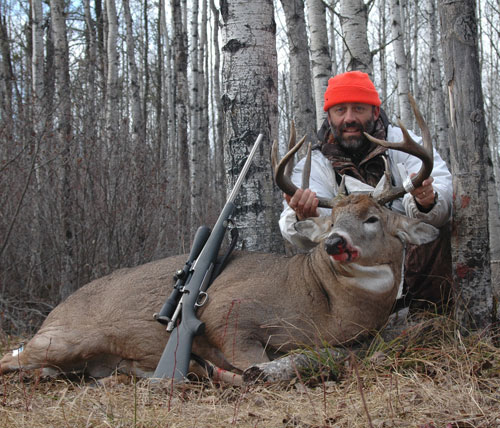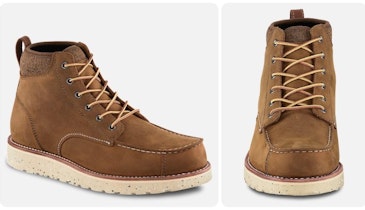![]() You step outside and the crisp, cold air hits you like a slap in the face. It’s dead still and a blanket of newly fallen snow covers the landscape. The eastern skyline reveals a narrow band of pinkish gray. It’s the dawn of a new day and few certainties lie ahead, except that every track is a fresh one, and at the end of each, there’s a deer. Your job is to find the right track, that of a big buck, and then stay with it until you end his days, or sunset ends yours. Many long hours and arduous miles lie ahead, but if you have the mettle, the mental determination and physical stamina to stay with it all day, you might just be rewarded before the sun sets.
You step outside and the crisp, cold air hits you like a slap in the face. It’s dead still and a blanket of newly fallen snow covers the landscape. The eastern skyline reveals a narrow band of pinkish gray. It’s the dawn of a new day and few certainties lie ahead, except that every track is a fresh one, and at the end of each, there’s a deer. Your job is to find the right track, that of a big buck, and then stay with it until you end his days, or sunset ends yours. Many long hours and arduous miles lie ahead, but if you have the mettle, the mental determination and physical stamina to stay with it all day, you might just be rewarded before the sun sets.
Sound old-fashioned, like a passage from some book written decades ago? Nobody really hunts that way anymore, except for a few fanatics of the far North, right? Admit it. By and large, we whitetail hunters have become a sedentary bunch, most of us preferring to while away the hours perched above a likely ambush spot. But make no mistake — while it might seem an anachronism, the traditional technique of cutting a track and following it to its logical conclusion is still widely practiced in the North Country. And some of the tactics involved have more widespread applications.
Getting Started
Know before you go that this game is not for the faint of heart or the out-of-shape. If you want to do it right and hope to be successful, you will need to be in shape both mentally and physically. And you’ll need to be a proficient woodsman. You might have to cover 10 or 12 miles of rough terrain in a day. To ply this tactic, you’ll need snow, and that only makes the travel harder. Through it all you must remain focused and alert, which is often the most difficult part. Let your concentration down, even for a moment, and hours of effort can be squandered. And you might even have to spend the night in the woods, or hike miles in the dark to get out. If your interest is still piqued, read on.
The next step is setting goals. In the state of Maine, where the craft was born and raised, there is a club that recognizes hunters who kill a buck with a dressed weight of 200 pounds or more. And some of those bucks dress out at considerably more. For most that’s the ultimate goal, one of those cagey, mature bucks who lives far from the trappings of man, in a place where you can walk all day without cutting the tracks of another human. That’s why those bucks are there; and that’s where you’ll look for them.
But be realistic. Are you ready to go toe-to-toe with the king of the forest? If you’re an experienced woodsman and deer hunter, you might be. But be honest. Maybe you’re better off starting with something smaller, any buck, or even a doe. And you might be better off plying your trade a little closer to home. The big woods can be mighty intimidating to someone who’s used to small suburban woodlots. In time you can work up to the big, big game. We’re almost ready.
Homework
Before you head out to look for the slotted tracks of a big-woods buck, you need to know where they live. Look for remote areas with relatively little hunting pressure. The more roadless and remote, the better. This isolation affords deer a chance to reach maturity and minimizes interference from other hunters. Call the state biologist, contact the local trophy club, study harvest records and topo maps to find areas that meet the necessary criteria. Then hit the woods when conditions are right, which usually means snow.
You’ll cover a lot more ground by driving the backwoods roads before daylight. Or, you could simply head into the woods and hope for the best. In that case, being familiar with an area will go a long way. Remember those tracks you followed last year? What about that rub line? Deer, especially older bucks, tend to be very faithful to an area. If you found good buck sign in years past, odds are good the deer will be there again in subsequent seasons.
The Right Track
Now you’re ready to look for a big buck track. But will you be able to recognize it when you see one? It will be 4 inches or longer. An even better indication is width. A track that is 3 ½ inches or more across is the one you want to follow. Compare your candidate with the size and sinking depth of other tracks nearby. The deeper the track, the heavier the deer that made it. And the fresher the track, the better your odds of finding its maker.
This is one of the places woodsmanship really plays a role. You need to be a good weatherman. Ask yourself: When did it last snow? How long has the snow been on the ground? How cold has it been? Did it warm up today and melt out part of the track? What type of snow is on the ground — wet, powder or granular? Do the tracks look like they were made in soft and wet or dry, frozen snow? Some of this will only come with experience, but you can always compare deer tracks with your own boot prints to see how they differ. Once you’ve determined the track is young and the deer that made it is old, it’s time to get moving.
 Concentration
Concentration
You’re on the track now, and whether you’re moving fast or slow, you’re constantly scanning ahead and off to the sides. Don’t watch your feet. Plan six or seven steps; look up and then walk. Set each step down slowly and quietly. Snow conditions will dictate your pace to some extent. If it’s noisy, you can set down your heel, or the outside of your foot, then “roll” the rest of your foot down, slowly shifting your weight with each step. Try to feel for twigs that might snap under your weight.
Don’t expect to find your deer standing in the open — though you might. Study the woods, looking for parts of a deer, like a patch of brown or the tell-tale horizontal line of its back or belly. If you’re an experienced hunter, you already have the search image, and these things will catch your eye. Look for any movement too, like the flick of an ear. Even when at rest, deer constantly check the wind and scan their radar-dish ears for any sound of approaching danger.
This is where good optics can really shine, and help slow you down. Stop every so often and glass. You’d be amazed how much more you can see. How often you need to stop will depend on how dense or how open the cover is.
Staying Alive
When you set out on the track, plan on spending the whole day in the woods, and be prepared in case you have to spend the night. You should always carry a basic survival kit with at least the following equipment. Obviously you’ll have a compass and knife. A high shrill whistle can help rescuers find you — three short blasts is a recognized distress signal. Pieces of hard candy or an energy bar will provide sustenance and peace of mind. It can get real cold at night, and you might need waterproof wooden matches and tinder for fire starting. A SPACE Brand Emergency Blanket folds up into a tiny packet, yet can be used for shelter, signaling, personal protection and warmth. Water purification tablets ensure you have safe drinking water. Finally, carry a small first aid kit with bandages, antiseptic and personal medication in case of injury or illness.






